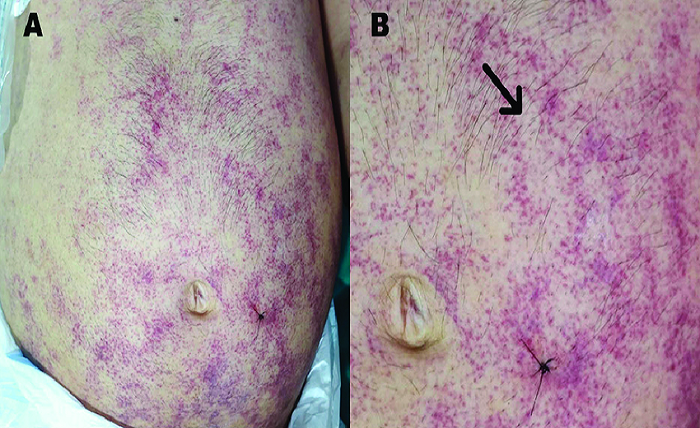Periumbilical: What Does It Mean and Why Is It Important?

Periumbilical is a medical term that describes the location or occurrence of something around or near the navel, or belly button. The navel is the scar that marks the former attachment of the umbilical cord, which connects the fetus to the placenta during pregnancy. The navel is located in the center of the abdomen, which is divided into nine regions for anatomical and clinical purposes. The region that contains the navel is called the umbilical region.
The umbilical region contains parts of several organs and structures, such as:
- the stomach
- the small intestine
- the large intestine
- the pancreas
- the mesentery
- the aorta
- the inferior vena cava
- the umbilical arteries and veins
The periumbilical area is important because it can be affected by various conditions and diseases that can cause pain, swelling, bleeding, or other symptoms. Some of these conditions and diseases are:
- umbilical hernia
- appendicitis
- mesenteric ischemia
- gastritis
- peptic ulcer
- pancreatitis
- abdominal aortic aneurysm
- superior vena cava syndrome
Causes and Symptoms of Periumbilical Conditions
The causes and symptoms of periumbilical conditions can vary depending on the specific condition and its severity. However, some common causes and symptoms are:
- Umbilical hernia: An umbilical hernia occurs when a part of an organ or tissue protrudes through a weak spot in the abdominal wall near the navel. It can be caused by increased pressure in the abdomen due to pregnancy, obesity, coughing, straining, or lifting heavy objects. It can cause a bulge, pain, or discomfort in the periumbilical area. It can also cause nausea, vomiting, or fever if the hernia becomes strangulated or infected.
- Appendicitis: Appendicitis is an inflammation of the appendix, which is a small pouch attached to the large intestine. It can be caused by a blockage or infection of the appendix. It can cause periumbilical pain that moves to the lower right side of the abdomen. It can also cause loss of appetite, nausea, vomiting, fever, or tenderness in the abdomen.
- Mesenteric ischemia: Mesenteric ischemia is a lack of blood flow to the mesentery, which is a fold of tissue that connects the intestines to the abdominal wall. It can be caused by a blood clot, atherosclerosis, low blood pressure, or heart failure. It can cause sudden or chronic periumbilical pain that worsens after eating. It can also cause nausea, vomiting, diarrhea, weight loss, or blood in the stool.
- Gastritis: Gastritis is an inflammation of the lining of the stomach. It can be caused by infection, medication, alcohol, stress, or autoimmune disorders. It can cause periumbilical pain that may radiate to the back or chest. It can also cause nausea, vomiting, loss of appetite, bloating, or indigestion.
- Peptic ulcer: A peptic ulcer is a sore that develops in the lining of the stomach or duodenum (the first part of the small intestine). It can be caused by infection, medication, alcohol, smoking, or stress. It can cause periumbilical pain that may occur between meals or at night. It can also cause nausea, vomiting, loss of appetite, weight loss, or bleeding in the stomach or duodenum.
- Pancreatitis: Pancreatitis is an inflammation of the pancreas, which is an organ that produces digestive enzymes and hormones. It can be caused by gallstones, alcohol abuse, trauma, infection, or medication. It can cause severe periumbilical pain that may radiate to the back or chest. It can also cause nausea, vomiting, fever, jaundice (yellowing of the skin and eyes), or shock.
- Abdominal aortic aneurysm: An abdominal aortic aneurysm is a bulge in the wall of the aorta (the largest artery in the body) that runs through the abdomen. It can be caused by atherosclerosis (hardening of the arteries), high blood pressure, smoking , age , or genetics . It can cause periumbilical pain that may pulsate or throb . It can also cause nausea , vomiting , fainting , or rupture (bleeding) of the aneurysm .
- Superior vena cava syndrome: Superior vena cava syndrome is a blockage or compression of the superior vena cava (the large vein that carries blood from the upper body to the heart). It can be caused by a tumor, a blood clot, an infection, or a chest injury. It can cause periumbilical swelling that may extend to the face, neck, arms, or chest. It can also cause difficulty breathing, coughing, hoarseness, or headache.
Diagnosis and Treatment of Periumbilical Conditions
The diagnosis and treatment of periumbilical conditions depend on the specific condition and its severity. However, some common methods are:
- Physical examination: A physical examination involves inspecting, palpating, auscultating, and percussing the abdomen and other parts of the body to look for signs and symptoms of periumbilical conditions. For example, a doctor may check for a bulge, tenderness, or pulsation in the periumbilical area.
- Blood tests: Blood tests involve taking a sample of blood from a vein and analyzing it for various markers of periumbilical conditions. For example, a doctor may check for elevated levels of white blood cells, inflammatory markers, liver enzymes, or pancreatic enzymes.
- Urine tests: Urine tests involve taking a sample of urine and analyzing it for various markers of periumbilical conditions. For example, a doctor may check for blood, bacteria, or ketones in the urine.
- Imaging tests: Imaging tests involve using various techniques to create images of the abdomen and other parts of the body to look for signs of periumbilical conditions. For example, a doctor may use ultrasound, X-ray, CT scan, MRI scan, or angiography to visualize the organs, structures, and blood vessels in the periumbilical area.
- Endoscopy: Endoscopy involves inserting a thin tube with a camera and a light into the mouth or anus and advancing it into the stomach or intestines to look for signs of periumbilical conditions. For example, a doctor may use gastroscopy or colonoscopy to examine the lining of the stomach or colon for ulcers or inflammation.
- Medication: Medication involves taking drugs orally or intravenously to treat the underlying cause or reduce the symptoms of periumbilical conditions. For example, a doctor may prescribe antibiotics, antacids, anti-inflammatories, painkillers, or anticoagulants to treat infection, acid reflux, inflammation, pain, or blood clots.
- Surgery: Surgery involves making an incision in the abdomen and operating on the affected organ or structure to treat the underlying cause or prevent complications of periumbilical conditions. For example, a doctor may perform appendectomy (removal of the appendix), hernia repair (fixing the hole in the abdominal wall), aneurysm repair (replacing the bulging part of the artery), or tumor removal (cutting out the abnormal growth).
Conclusion
Periumbilical is a medical term that describes the location or occurrence of something around or near the navel. The navel is located in the center of the abdomen, which contains parts of several organs and structures. The periumbilical area is important because it can be affected by various conditions and diseases that can cause pain , swelling , bleeding , or other symptoms . Some of these conditions and diseases are umbilical hernia , appendicitis , mesenteric ischemia , gastritis , peptic ulcer , pancreatitis , abdominal aortic aneurysm , and superior vena cava syndrome . The diagnosis and treatment of periumbilical conditions depend on the specific condition and its severity. However , some common methods are physical examination , blood tests , urine tests , imaging tests , endoscopy , medication , and surgery . Periumbilical conditions can be serious and require medical attention. Therefore , if you experience periumbilical symptoms frequently or severely , you should consult your doctor for diagnosis and treatment .




